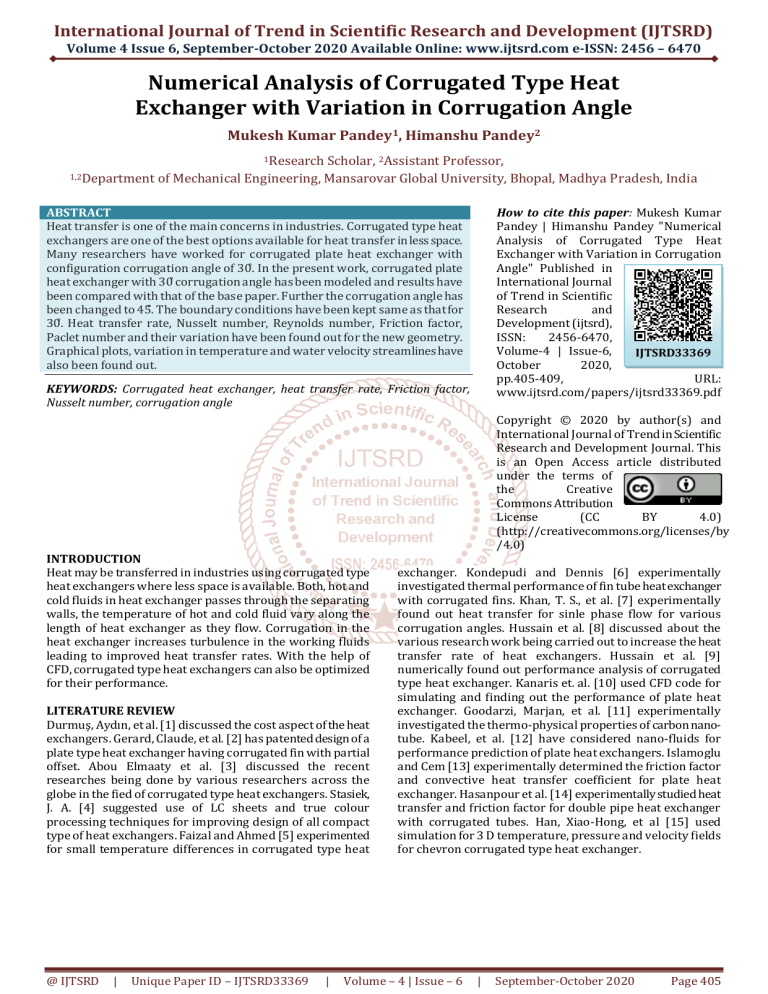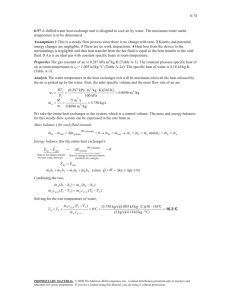
International Journal of Trend in Scientific Research and Development (IJTSRD)
Volume 4 Issue 6, September-October 2020 Available Online: www.ijtsrd.com e-ISSN: 2456 – 6470
Numerical Analysis of Corrugated Type Heat
Exchanger with Variation in Corrugation Angle
Mukesh Kumar Pandey1, Himanshu Pandey2
1Research
Scholar, 2Assistant Professor,
1,2Department of Mechanical Engineering, Mansarovar Global University, Bhopal, Madhya Pradesh, India
ABSTRACT
Heat transfer is one of the main concerns in industries. Corrugated type heat
exchangers are one of the best options available for heat transfer in less space.
Many researchers have worked for corrugated plate heat exchanger with
configuration corrugation angle of 30̊. In the present work, corrugated plate
heat exchanger with 30̊ corrugation angle has been modeled and results have
been compared with that of the base paper. Further the corrugation angle has
been changed to 45̊. The boundary conditions have been kept same as that for
30̊. Heat transfer rate, Nusselt number, Reynolds number, Friction factor,
Paclet number and their variation have been found out for the new geometry.
Graphical plots, variation in temperature and water velocity streamlines have
also been found out.
How to cite this paper: Mukesh Kumar
Pandey | Himanshu Pandey "Numerical
Analysis of Corrugated Type Heat
Exchanger with Variation in Corrugation
Angle" Published in
International Journal
of Trend in Scientific
Research
and
Development (ijtsrd),
ISSN:
2456-6470,
Volume-4 | Issue-6,
IJTSRD33369
October
2020,
pp.405-409,
URL:
www.ijtsrd.com/papers/ijtsrd33369.pdf
KEYWORDS: Corrugated heat exchanger, heat transfer rate, Friction factor,
Nusselt number, corrugation angle
INTRODUCTION
Heat may be transferred in industries using corrugated type
heat exchangers where less space is available. Both, hot and
cold fluids in heat exchanger passes through the separating
walls, the temperature of hot and cold fluid vary along the
length of heat exchanger as they flow. Corrugation in the
heat exchanger increases turbulence in the working fluids
leading to improved heat transfer rates. With the help of
CFD, corrugated type heat exchangers can also be optimized
for their performance.
LITERATURE REVIEW
Durmuş, Aydın, et al. [1] discussed the cost aspect of the heat
exchangers. Gerard, Claude, et al. [2] has patented design of a
plate type heat exchanger having corrugated fin with partial
offset. Abou Elmaaty et al. [3] discussed the recent
researches being done by various researchers across the
globe in the fied of corrugated type heat exchangers. Stasiek,
J. A. [4] suggested use of LC sheets and true colour
processing techniques for improving design of all compact
type of heat exchangers. Faizal and Ahmed [5] experimented
for small temperature differences in corrugated type heat
@ IJTSRD
|
Unique Paper ID – IJTSRD33369
|
Copyright © 2020 by author(s) and
International Journal of Trend in Scientific
Research and Development Journal. This
is an Open Access article distributed
under the terms of
the
Creative
Commons Attribution
License
(CC
BY
4.0)
(http://creativecommons.org/licenses/by
/4.0)
exchanger. Kondepudi and Dennis [6] experimentally
investigated thermal performance of fin tube heat exchanger
with corrugated fins. Khan, T. S., et al. [7] experimentally
found out heat transfer for sinle phase flow for various
corrugation angles. Hussain et al. [8] discussed about the
various research work being carried out to increase the heat
transfer rate of heat exchangers. Hussain et al. [9]
numerically found out performance analysis of corrugated
type heat exchanger. Kanaris et. al. [10] used CFD code for
simulating and finding out the performance of plate heat
exchanger. Goodarzi, Marjan, et al. [11] experimentally
investigated the thermo-physical properties of carbon nanotube. Kabeel, et al. [12] have considered nano-fluids for
performance prediction of plate heat exchangers. Islamoglu
and Cem [13] experimentally determined the friction factor
and convective heat transfer coefficient for plate heat
exchanger. Hasanpour et al. [14] experimentally studied heat
transfer and friction factor for double pipe heat exchanger
with corrugated tubes. Han, Xiao-Hong, et al [15] used
simulation for 3 D temperature, pressure and velocity fields
for chevron corrugated type heat exchanger.
Volume – 4 | Issue – 6
|
September-October 2020
Page 405
International Journal of Trend in Scientific Research and Development (IJTSRD) @ www.ijtsrd.com eISSN: 2456-6470
GEOMETRY, DESCRITISATION AND BOUNDARY CONDITIONS
Geometry of pressure vessel has been modeled in Solid works and meshing has been done in ANSYS.
Fig 1: Sketch of corrugated type heat exchanger
After creation of geometry the mesh of the pressure vessel has been generated using the default values.
Boundary Conditions
Outer surface has been considered to be adiabatic. Hot fluid inlet temperature has been considered at 353 K with mass flow
rate ranging from 2 to 5 lpm. Cold fluid inlet temperature has been taken as 303 K with mass flow rate of 2 lpm. Outlet pressure
for both the fluids is considered to be at atmospheric pressure.
RESULTS AND DISCUSSIONS
Validation of Result
For validation of results geometry with 30 degree corrugation angle has been analysed and results are found to be in good
agreement.
Fig 2: Variation in heat transfer rate of hot fluid with variation in volumetric flow rate
After validation of result for 30° corrugated plate heat exchanger, the corrugation angle has been modified. New angle of
corrugation which has been considered is 45̊.
Fig 3: 3 D view of modified plate
@ IJTSRD
|
Unique Paper ID – IJTSRD33369
|
Volume – 4 | Issue – 6
|
September-October 2020
Page 406
International Journal of Trend in Scientific Research and Development (IJTSRD) @ www.ijtsrd.com eISSN: 2456-6470
Graphical Plots
Graphical plots have been obtained for temperature to visualize the effect of variation in flow rates.
Fig. 4: Temperature contour for 2LPM
Fig.5: Temperature contour for 3LPM
Fig. 6: Temperature contour for 4LPM
From the above temperature contours, it is observed that on increasing flow rate, the higher temperature is obtained on the
surface near the exit of the hot fluid. As the flow of hot fluid increases, temperature of the cold fluid rises rapidly than at lower
flow rates. Increase in turbulent kinetic energy with the increased hot water velocity can be the possible reason for that.
Velocity Streamlines
Velocity streamlines have been obtained for variation in flow velocity for all the cases
@ IJTSRD
|
Unique Paper ID – IJTSRD33369
|
Volume – 4 | Issue – 6
|
September-October 2020
Page 407
International Journal of Trend in Scientific Research and Development (IJTSRD) @ www.ijtsrd.com eISSN: 2456-6470
Fig. 7: Water velocity streamline for 2LPM
Fig. 8: Water velocity streamline for 3 LPM
Fig. 9: Water velocity streamline for 5LPM
With increase in flow rates, water velocity increases. It can be observed from water velocity streamlines that water leaves the
heat exchanger with lower velocity as compared to the velocity of water at inlet. This can be due to loss of velocity due to
friction while flowing from inlet to outlet. With the help of function calculators all the parameters at desired locations have
been found out. The obtained values have been shown in figures.
@ IJTSRD
|
Unique Paper ID – IJTSRD33369
|
Volume – 4 | Issue – 6
|
September-October 2020
Page 408
International Journal of Trend in Scientific Research and Development (IJTSRD) @ www.ijtsrd.com eISSN: 2456-6470
Fig. 10: Change in overall heat transfer with volumetric rate of hot fluid
There is high overall heat transfer coefficient from hot fluid to cold fluid for 30° corrugation angle than 45° corrugation angle.
Fig. 5.11- Variation of heat transfer rate with hot water volumetric flow rate
On increasing the flow rate of hot fluid heat transfer coefficient rises. Similar trend has been observed for variation in heat
transfer coefficient by Pandey and Nema [12].
CONCLUSIONS
For increase in mass flow of hot fluid, heat transfer rate
increases. Heat transfer rate of 45̊ corrugated plate heat
exchanger is lower than heat transfer rate of 30̊ corrugated
plate heat exchanger. Friction factor of 45̊ corrugated plate
heat exchanger is higher than friction factor of 30̊ corrugated
plate heat exchanger. Higher corrugation angle leads to
higher turbulence but reduces the effectiveness of the heat
exchanger.
[7] Kabir, Mohammad Z. "Finite element analysis of
composite pressure vessels with a load sharing
metallic liner." Composite structures 49.3 (2000): 247255.
References
[1] KSS, RAO YARRAPRAGADA, R. KRISHNA MOHAN, and
B. VIJAY KIRAN. "Composite pressure vessels."
International Journal of Research in Engineering and
Technology 1.4 (2002).
[9] Teng, J. G., T. Yu, and D. Fernando. "Strengthening of
steel structures with fiber-reinforced polymer
composites." Journal
of
Constructional
Steel
Research 78 (2012): 131-143.
[2] Hossam, I., Sh Saleh, and H. Kamel. "Review of
challenges of the design of rocket motor case
structures." IOP Conference Series: Materials Science
and Engineering. Vol. 610. No. 1. IOP Publishing, 2019.
[3] Kleber, Richard M., et al. "Composite pressure vessel
and method of assembling the same." U.S. Patent No.
8,757,423. 24 Jun. 2014.
[4] Briggs, Kerry D. "High pressure flexible pipe." U.S.
Patent No. 4,850,395. 25 Jul. 1989.
[5] Mhetre, Tejas Vasant. Finite Element Analysis of
Composite Reactor Pressure Vessel. Diss. 2018.
[6] Praneeth¹, Bandarupalli, and T. B. S. Rao. "Finite
element analysis of pressure vessel and piping design."
@ IJTSRD
|
Unique Paper ID – IJTSRD33369
|
International Journal of Engineering Trends and
Technology-Volume3Issue5-2012 (2012).
[8] Von Oepen, Randolf, Axel Grandt, and Thomas Rieth.
"Catheter having plurality of stiffening members." U.S.
Patent No. 7,785,318. 31 Aug. 2010.
[10] Alderliesten, Rene. "On the development of hybrid
material concepts for aircraft structures." Recent
Patents on Engineering 3.1 (2009): 25-38.
[11] Behera, Ajit, Swadhin Patel, and Manisha Priyadarshini.
"Fiber-reinforced
metal
matrix
nanocomposites." Fiber-Reinforced Nanocomposites:
Fundamentals and Applications. Elsevier, 2020. 147156.
[12] Pandey S. D. and Nema, V. K. Experimental analysis of
heat transfer and friction factor of nanofluid as a
coolant in a corrugated plate heat exchanger.
Experimental Thermal and Fluid Science, 2012; 38,
pp.248-256.
Volume – 4 | Issue – 6
|
September-October 2020
Page 409




